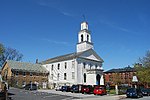North Bedford Historic District
Historic districts in Bristol County, MassachusettsHistoric districts on the National Register of Historic Places in MassachusettsNRHP infobox with nocatNational Register of Historic Places in New Bedford, MassachusettsNew Bedford, Massachusetts ... and 1 more
Use mdy dates from August 2023

The North Bedford Historic District is a historic district roughly bounded by Summer, Parker, Pleasant and Kempton Streets in New Bedford, Massachusetts. It encompasses a predominantly residential neighborhood north of downtown New Bedford which was developed primarily in the mid 19th-century. It features a variety of worker housing of the period, as well as a number of higher quality houses built by businessmen. The district was added to the National Register of Historic Places in 1979.
Excerpt from the Wikipedia article North Bedford Historic District (License: CC BY-SA 3.0, Authors, Images).North Bedford Historic District
Walden Street, New Bedford
Geographical coordinates (GPS) Address Nearby Places Show on map
Geographical coordinates (GPS)
| Latitude | Longitude |
|---|---|
| N 41.640277777778 ° | E -70.930277777778 ° |
Address
Walden Street 75
02740 New Bedford
Massachusetts, United States
Open on Google Maps







